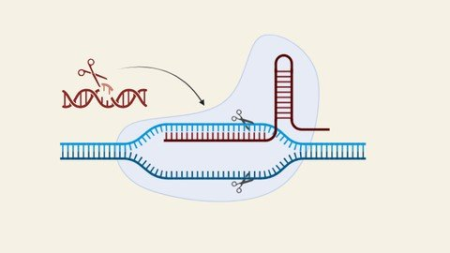Biotechnology: Gene Editing Techniques
11
August
2022
Published 8/2022MP4 | Video: h264, 1280x720 | Audio: AAC, 44.1 KHzLanguage: English | Size: 592.16 MB | Duration: 1h 9m
Learn about gene editing techniques like ZFNs, TALEN, and CRISPR
What you'll learn
What is Gene Editing
History of Gene Editing
How Does Gene Editing Work
Homologous Recombination
Peptide Nucleic Acids (PNAs)
Meganuclease
Zinc-finger nuclease (ZFNs)
Transcription activator-like effector nucleases (TALEN)
General Mechanism of CRISPR/Cas
Types I CRISPR/Cas System
Types II CRISPR/Cas System
Types III CRISPR/Cas System
Ethical Concerns Related to Gene Editing
Applications of Gene Editing
Requirements
Basic knowledge of biology, Biotechnology, and molecular biology
Interested in learning latest techniques
Motivation to Learn
Description
Over the last half century after post-DNA helical structure discovery, the world has seen a continuous staircase outburst of various molecular technologies, which are now heading forward toward translation into clinical and laboratory practice. Given the availability of sequencing platforms, acquired wisdom about the micro-mechanics at work within the genetic apparatus, and the introduction of user-friendly nanotechnologies, it was possible for next-generation scientists to manipulate the genetic codes at various levels.Principally, gene editing techniques can be interpreted as methods where DNA sequences are changed by deletions, mRNA processing, and post-transcriptional modifications to result in altered gene expression, leading to functional behavior of proteinsGene editing is performed using enzymes, particularly nucleases that have been eeered to target a specific DNA sequence, where they introduce cuts into the DNA strands, enabling the removal of existing DNA and the insertion of replacement DNA. The enormous knowledge and ongoing research have now been able to demonstrate methodologies that can alter DNA coding. The gene editing techniques evolved from the earlier attempts like nuclease technologies, homologous recombination, and certain chal methods (peptide nucleic acid). Molecular techniques like meganuclease, transcription activator-like effector nucleases (TALENs), and zinc-finger nucleases (ZFNs) initially emerged as genome-editing technologies.These initial technologies suffer from lower specificity due to their off-targets side effects. Moreover, from biotechnology's perspective, the main obstacle was to develop simple but effective delivery methods for host cell entry. The latest discovery of CRISPR/Cas9 technology seems more encouraging by providing better efficiency, feasibility, and multi-role clinical application. The significant leap in gene editing techniques brought new urgency to long standing discussions about the ethical concerns surrounding the genetic eeering. Many questions, such as whether genetic eeering should be used to treat human disease or to alter traits such as beauty or intelligence, had been asked in one form or another for decades. This course generally discusses the various gene editing techniques in terms of the mechanisms of action, advantages, and side effects.This course is a valuable resource for students and researchers related to molecular biology, forensic science, medical laboratory technology, biotechnology, and genetics. Start your learning journey now and explore the hidden truth about nature!
Overview
Section 1: Overview
Lecture 1 Overview
Section 2: Gene Editing
Lecture 2 What is Gene Editing
Lecture 3 History of Gene Editing
Lecture 4 How Does Gene Editing Work
Section 3: Gene Editing Techniques
Lecture 5 Gene Editing Techniques
Lecture 6 Resources
Section 4: Conventional System
Lecture 7 Homologous Recombination
Lecture 8 Mechanism of Homologous Recombination
Lecture 9 Limitations Of Homologous Recombination
Section 5: Chal System
Lecture 10 Peptide Nucleic Acids
Lecture 11 Mechanism and Limitations of Peptide Nucleic Acid
Section 6: Protein-Based Nuclease Systems
Lecture 12 Meganuclease
Lecture 13 Eeering of Meganuclease
Lecture 14 Mechanism of Meganuclease
Lecture 15 Zinc-Finger Nuclease
Lecture 16 Structure of Zinc-Finger Nuclease
Lecture 17 Mechanism of Zinc-Finger Nuclease
Lecture 18 Limitations and Strength of Zinc-Finger Nuclease
Lecture 19 TALEN
Lecture 20 Mechanism of TALEN
Lecture 21 Limitations and Strength of TALEN
Section 7: RNA Protein Based Systems
Lecture 22 CRISPR
Lecture 23 General Mechanism of CRISPR/Cas
Lecture 24 Types of CRISPR/Cas System
Lecture 25 Types II CRISPR/Cas System
Lecture 26 Types I CRISPR/Cas System
Lecture 27 Types III CRISPR/Cas System
Lecture 28 Limitations and Strength of CRISPR/Cas
Section 8: Ethical Concerns
Lecture 29 Ethical Concerns
Section 9: Applications of Gene Editing
Lecture 30 Applications of Gene Editing
Lecture 31 For further Reading
Students who want to go for lab technologist and molecular biologists job.,Researchers of molecular biology, biotechnology, and related disciplines.,Students who wants to persude their carrer in forensic science, medicine, research, molecular biology, and genetics.
HomePage:
[url]Https://anonymz.com/https://www.udemy.com/course/biotechnology-gene-editing-techniques/[/url]
DOWNLOAD
1dl.net
https://1dl.net/fa1kdfcbq4s9/Y90Zc4MS__Biotechnol.rar.html
rapidgator.net
https://rapidgator.net/file/8f7746346fcaa9dccd68830ca3fd774a/Y90Zc4MS__Biotechnol.rar.html
Note:
Only Registed user can add comment, view hidden links and more, please register now
Only Registed user can add comment, view hidden links and more, please register now